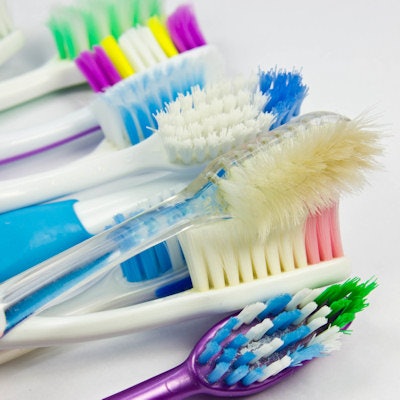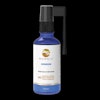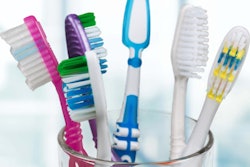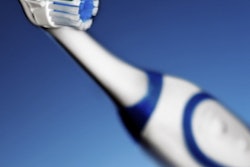
Do you tell your patients when to replace their toothbrushes? Do you know when they should? Researchers of a new study looked at the relationship between toothbrush wear and plaque scores, and they recommended throwing out the practice of equating toothbrush wear with toothbrush age.
The researchers examined toothbrush wear after three months of use and plaque levels in study participants and found a significant relationship between greater toothbrush wear and higher plaque scores. Their study was published in the International Journal of Dental Hygiene (October 16, 2018).
"Toothbrushes with extreme wear were less effective than those with no or light wear," the authors wrote. "Therefore, bristle splaying appears to be a more appropriate measure of brush replacement time than the commonly used toothbrush age."
They were led by M.P.C. van Leeuwen of the department of periodontology at the Academic Center for Dentistry Amsterdam in the Netherlands.
Age is just a number
The length of time people are told to use a manual toothbrush before throwing it away may vary according to the source providing the information and does not seem to be based on scientific evidence, the authors noted. The ADA recommends replacement every three to four months or sooner if the bristles become frayed, while surveys of dental professionals show that they recommend two to three months, according to the authors.
“Bristle splaying appears to be a more appropriate measure of brush replacement time than the commonly used toothbrush age.”
Criteria for replacing a toothbrush also can vary, with some literature suggesting that plaque removal decreases with toothbrush wear and not age and with splaying of the outer tufts beyond the base, they explained. However, some of this research was based on only a small number of study participants.
In addition, previous research has found that toothbrush bristles that are spread apart develop permanent curvatures and that differences in wear are caused by variations in toothbrushing forces and techniques among individuals, the authors noted.
The researchers of the current study analyzed data from participants in a previous study to determine the relationship between plaque scores and toothbrush wear and whether this information might provide a more appropriate basis for toothbrush replacement.
They required that participants in their study were at least 18 years old and not pregnant and also met the following criteria:
- Had no systemic disorders
- Had at least five evaluable teeth per quadrant
- Had moderate to advanced gingivitis (40% or greater bleeding on marginal probing)
- Had no open caries
- Had Dutch Periodontal Screening Index scores of less than 3+
- Wore no orthodontic appliances or removable (partial) dentures
The investigators directed study participants to brush twice daily for two minutes according to the Bass method, about which they were given written instructions, and to brush two to three hours before appointments. They provided participants with a fluoride dentrifice (Zendium Classic,Unilever) and toothbrush (IQ Soft,Lactona) and also instructed them not to use other dental products or interdental cleaning aids or undergo dental prophylaxis during routine dental checkups.
Study participants returned for follow-up every three months, at which time they handed in their used toothbrush and received a new one, and underwent plaque score assessment based on the modified Quigley Hein plaque index. The researchers assessed the degree of wear of each toothbrush on a five-point scale (see table below).
| Toothbrush wear scores | |||||
| Wear scores | 0 No wear |
1 Light wear |
2 Medium wear |
3 Heavy wear |
4 Extreme wear |
| Descriptions | No visible signs of wear. Inner and outer tufts are intact. | Outer tufts begin to splay. Inner tufts are still intact. | Outer tufts are splayed beyond the base of the toothbrush. Inner tufts begin to splay. | Outer and inner tufts are splayed. | Outer and inner tufts are splayed whereby no distinction can be made. |
They included data from after the four-month evaluation when the clinically assessed parameters from the original study had worn off. They found no significant differences between groups. Additionally, they used data in the current analysis only from participants who returned their toothbrush at every visit (172 of those enrolled in the original study) and three toothbrushes from each of them.
The researchers ultimately found a significant (p < 0.0001) but weak positive correlation between toothbrush wear scores and plaque scores. They also calculated that participants with toothbrushes that had the most wear (score 4) had significantly higher plaque scores (plaque index = 1.98) than those with toothbrushes with no visible wear (score 0, plaque index = 1.71) or light wear (score 1, plaque index = 1.80). The wear status of a participant's toothbrush strongly correlated with that of their other toothbrushes (p < 0.0001), at the same time as it varied widely among individuals.
"With respect to toothbrushing efficacy, it seems that the age of a toothbrush should not be the factor guiding replacement," the authors wrote. "Instead, the level of wear appeared to be more important."
Who wore it best?
The authors cited several study limitations, including that the results related only to the specific toothbrush type used and the character of the study population, and the wear index used was subjective.
Unfortunately, toothbrush users may not know that their toothbrush needs to be replaced, the author wrote. However, since the amount of plaque removed by a toothbrush with a wear score of 4 was significantly different from one with a score of 1 or greater, they recommended that practitioners advise patients to replace their toothbrush before it reaches a wear score of 2 and provide patients with a simple picture of a worn toothbrush head, along with a short explanation.
"Splaying of the outer tufts beyond the base of the toothbrush is a condition that indicates it is time to change the brush," the authors concluded.



















